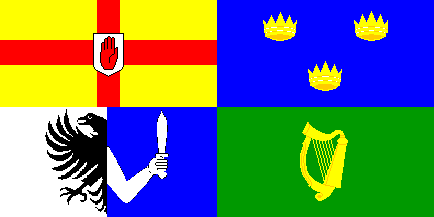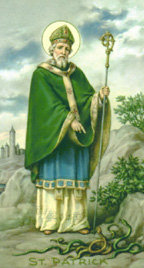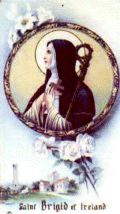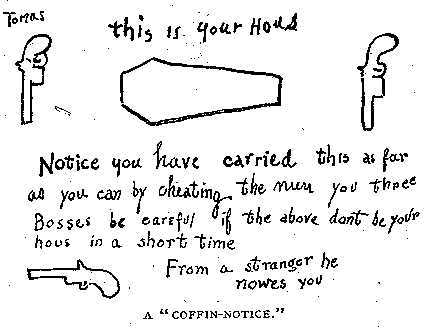You are listening to "Lord Nelson"
 |
 |
 |
 |

The flag of Irelad - four provinces |
SAINT PATRICK |
 
|
|
Patrick of Ireland
Born in Scotland, c. 385-390; died in Ireland c. 461. "ST. PATRICK'S BREASTPLATE"
"I bind to myself today
The strong virtue of the Incarnation of Christ with his Baptism,
I bind to myself today
The power of Heaven,
I bind to myself today
God's power to guide me,
I bind to myself today
I invoke today all these virtues
That I may receive abundant reward.
The strong virtue of the Invocation of the Trinity. |
|
Patrick's cultus there reverts to the legend of Les Fleurs de St- Patrice which relates that Patrick was sent from the abbey to preach the Gospel in the area of Bréhémont-sur-Loire. He went fishing one day and had a tremendous catch. The local fishermen were upset and forced him to flee. He reached a shelter on the north bank where he slept under a blackthorn bush. When he awoke the bush was covered with flowers. Because this was Christmas day, the incident was considered a miracle, which recurred each Christmas until the bush was destroyed in World War I. The phenomenon was evaluated many times and verified by various observers, including official organizations. His is now the patron of the fishermen on the Loire and, according to a modern French scholar, the patron of almost every other occupation in the neighborhood. There is a grotto dedicated to him at Marmoutier, which contains a stone bed, alleged to have been his. It is said that in visions he heard voices in the wood of Focault or that he dreamed of Ireland and determined to return to the land of his slavery as a missionary. In that dream or vision he heard a cry from many people together "come back and walk once more among us," and he read a writing in which this cry was named 'the voice of the Irish.' (When Pope John Paul II went to Ireland in 1979, among his first words were that he, too, had heard the "voice of the Irish.") In his Confessio Patrick writes: "It was not my grace, but God who overcometh in me, so that I came to the heathen Irish to preach the Gospel . . . to a people newly come to belief which the Lord took from the ends of the earth." Saint Germanus consecrated him bishop about 432, and sent him to Ireland to succeed Saint Palladius, the first bishop, who had died earlier that year. There was some opposition to Patrick's appointment, probably from Britain, but Patrick made his way to Ireland about 435. He set up his see at Armagh and organized the church into territorial sees, as elsewhere in the West and East. While Patrick encouraged the Irish to become monks and nuns, it is not certain that he was a monk himself; it is even less likely that in his time the monastery became the principal unit of the Irish Church, although it was in later periods. The choice of Armagh may have been determined by the presence of a powerful king. There Patrick had a school and presumably a small familia in residence; from this base he made his missionary journeys. There seems to have been little contact with the Palladian Christianity of the southeast. There is no reliable account of his work in Ireland, where he had been a captive. Legends include the stories that he drove snakes from Ireland, and that he described the Trinity by referring to the shamrock, and that he singlehandedly--an impossible task--converted Ireland. Nevertheless, Saint Patrick established the Catholic Church throughout Ireland on lasting foundations: he travelled throughout the country preaching, teaching, building churches, opening schools and monasteries, converting chiefs and bards, and everywhere supporting his preaching with miracles. At Tara in Meath he is said to have confronted King Laoghaire on Easter Eve with the Christian Gospel, kindled the light of the paschal fire on the hill of Slane (the fire of Christ never to be extinguished in Ireland), confounded the Druids into silence, and gained a hearing for himself as a man of power. He converted the king's daughters (a tale I've recounted under the entry for Saints Ethenea and Fidelmia. He threw down the idol of Crom Cruach in Leitrim. Patrick wrote that he daily expected to be violently killed or enslaved again. He gathered many followers, including Saint Benignus, who would become his successor. That was one of his chief concerns, as it always is for the missionary Church: the raising up of native clergy. He wrote: "It was most needful that we should spread our nets, so that a great multitude and a throng should be taken for God. . . . Most needful that everywhere there should be clergy to baptize and exhort a people poor and needy, as the Lord in the Gospel warns and teaches, saying: Go ye therefore now, and teach all nations. And again: Go ye therefore into the whole world and preach the Gospel to every creature. And again: This Gospel of the Kingdom shall be preached in the whole world for a testimony to all nations." In his writings and preaching, Patrick revealed a scale of values. He was chiefly concerned with abolishing paganism, idolatry, and sun-worship. He made no distinction of classes in his preaching and was himself ready for imprisonment or death for following Christ. In his use of Scripture and eschatological expectations, he was typical of the 5th-century bishop. One of the traits which he retained as an old man was a consciousness of his being an unlearned exile and former slave and fugitive, who learned to trust God completely. There was some contact with the pope. He visited Rome in 442 and 444. As the first real organizer of the Irish Church, Patrick is called the Apostle of Ireland. According to the Annals of Ulster, the Cathedral Church of Armagh was founded in 444, and the see became a center of education and administration. Patrick organized the Church into territorial sees, raised the standard of scholarship (encouraging the teaching of Latin), and worked to bring Ireland into a closer relationship with the Western Church. His writings show what solid doctrine he must have taught his listeners. His Confessio (his autobiography, perhaps written as an apology against his detractors), the Lorica (or Breastplate), and the "Letter to the Soldiers of Coroticus," protesting British slave trading and the slaughter of a group of Irish Christians by Coroticus's raiding Christian Welshmen, are the first surely identified literature of the British or Celtic Church.
|
|
His writings show what solid doctrine he must have taught his listeners. His Confessio (his autobiography, perhaps written as an apology against his detractors), the Lorica (or Breastplate), and the "Letter to the Soldiers of Coroticus," protesting British slave trading and the slaughter of a group of Irish Christians by Coroticus's raiding Christian Welshmen, are the first surely identified literature of the British or Celtic Church. What stands out in his writings is Patrick's sense of being called by God to the work he had undertaken, and his determination and modesty in carrying it out: "I, Patrick, a sinner, am the most ignorant and of least account among the faithful, despised by many. . . . I owe it to God's grace that so many people should through me be born again to him." Towards the end of his life, Patrick made that 'retreat' of forty days on Cruachan Aigli in Mayo from which the age-long Croagh Patrick pilgrimage derives. Patrick may have died at Saul on Strangford Lough, Downpatrick, where he had built his first church. Glastonbury claims his alleged relics. The National Museum at Dublin has his bell and tooth, presumably from the shrine at Downpatrick, where he was originally entombed with Saints Brigid and Columba. The high veneration in which the Irish hold Patrick is evidenced by the common salutation, "May God, Mary, and Patrick bless you." His name occurs widely in prayers and blessings throughout Ireland. Among the oldest devotions of Ireland is the prayer used by travellers invoking Patrick's protection, An Mhairbhne Phaidriac or The Elegy of Patrick. He is alleged to have promised prosperity to those who seek his intercession on his feast day, which marks the end of winter. A particularly lovely legend is that the Peace of Christ will reign over all Ireland when the Palm and the Shamrock meet, which means when St. Patrick's Day fall on Passion Sunday. Most unusual is Well of Saint Patrick at Orvieto, Italy, which was built at the order of Pope Clement VII in 1537 to provide water for the city during its periodic sieges. The connection with Saint Patrick comes from the fact that the project was completed and dedicated by a member of the Sangallo family, a name derived from the Irish Saint Gall. A common Italian proverb refers to this exceptionally deep (248 steps to the surface) well: liberal spenders are said to have pockets as deep as the Well of Patrick (Attwater, Benedictines, Bentley, Bieler, Bury, Delaney, Encyclopedia, Farmer, MacNeill, Montague, White). We are told that often Patrick baptized hundreds on a single day. He would come to a place, a crowd would gather, and when he told them about the true God, the people would cry out from all sides that they wanted to become Christians. Then they would move to the nearest water to be baptized. On such a day Aengus, a prince of Munster, was baptized. When Patrick had finished preaching, Aengus was longing with all his heart to become a Christian. The crowd surrounded the two because Aengus was such an important person. Patrick got out his book and began to look for the place of the baptismal rite but his crozier got in the way. As you know, the bishop's crozier often has a spike at the bottom end, probably to allow the bishop to set it into the ground to free his hands. So, when Patrick fumbled searching for the right spot in the book so that he could baptize Aengus, he absent-mindedly stuck his crosier into the ground just beside him--and accidentally through the foot of poor Aengus! Patrick, concentrating on the sacrament, never noticed what he had done and proceeded with the baptism. The prince never cried out, nor moaned; he simply went very white. Patrick poured water over his bowed head at the simple words of the rite. Then it was completed. Aengus was a Christian. Patrick turned to take up his crozier and was horrified to find that he had driven it through the prince's foot! "But why didn't you say something? This is terrible. Your foot is bleeding and you'll be lame. . . ." Poor Patrick was very unhappy to have hurt another. Then Aengus said in a low voice that he thought having a spike driven through his foot was part of the ceremony. He added something that must have brought joy to the whole court of heaven and blessings on Ireland: "Christ," he said slowly, "shed His blood for me, and I am glad to suffer a little pain at baptism to be like Our Lord" (Curtayne).
In art, Saint Patrick is represented as a bishop driving snakes before him or trampling upon them. At times he may be shown : |
St. Colmcille |
| St. Columba 521-597, Born probaly in Donegal Ireland of royal descent he studied at Moville under St. Finnian then in Leinster at the monastery of Clonard under another St. Finnian. He was ordained before he was twenty-five and spent the next fifteen years preaching and setting up foundations at Derry, Durrow, and Kells. Possibly because of a family feud which resulted in the death of 3000 and for which he considered himself partly responsible he left Ireland at 42 and landed on the island of Iona off the coast of Scotland. There he built the monastery which was to become world famous. With SS Canice and Comgall he spread the gospel to the Picts; he also developed a monastic rule which many followed until the introduction of St. Benedicts. He died on Iona and is also known as Colm, Colum and Columcille. Feast day is June 9. |
 |  |  |  |

|
READING PENNSYLVANIA TO CONCEPTION MISSOURI |
|
Founding of an Irish Catholic Colony in the West - In MS Word Format The founding of the first Irish Catholic Colony in PDF Format |
|
The Mollie Maguires & the A.O.H. in MS Word Format. The Mollie Macguires & the AOH in PDF Format |  "Mollie Maguire" warning notice |
|
Current History - Division #1 |
|
Current History - Division #2 |
|
Current History - Berks County Board |

|
|
EIRNUA |
|
Proclamation of the Irish Republic - 1916 Irish History ... The rebirth of Sinn Fein - 1917 |
|
Sinn Fein as we know it today, owes much to the important Ard Fheis held in Dublin's Mansion House on October 25, 1917. The basis for the socialist republican program of later years was laid at that Ard Fheis, as were the main elelments of today's Sinn Fein Constitution. Many who were called Sinn Feiners in 1917 were not part of Sinn Fein but were in fact members of one of the many other nationalist or republican groups which were spreading across the country. Prior to the Rising, Arthur Griffith's Sinn Fein was floundering, but by mid-1917, with a huge influx of members, Sinn Fein clubs were appearing across the country. Such were their numbers that the affiliation fees allowed for the maintenance of a head office at Harcourt Street in Dublin and for two paid organizers to take to the roads. In the main, the members ignored the original stated aim of Arthur Griffith of the re-establishment of King and Commons in Ireland. Similar to many others in Ireland at the time, they regarded themselves as republicans. The liberty clubs suggested by Count Plunkett after his by-election victory earlier in the year were also expanding rapidly, often having clubs in the same town as a Sinn Fein club. They were at a disadvantage, not having the false reputation of having organized the 1916 Rising or having a central office. The volunteers were also growing rapidly but were antagonistic to Arthur Griffith's Dual-Monarchy proposals. The Fractious nature of republicanism was a cause of concern for many of the leaders of the various republican groups. A meeting of the Mansion House Committee (set up in April 1917 to pursue the unification of all republicans under one banner) was held in Cathal Brugha's house in Upper Rathmines and was hot and heavy. It was suggested to Griffith that he hand over Sinn Fein to the Volunteers, but Griffith was having none of it: "Sinn Fein will not give up its name. I was elected president by a convention of Sinn Fein and I can only give over the presidency to somebody elected by another convention."
Nearing the end of the debate Thomas Dillon said that the alternatives open were to found a new organization or take over Sinn Fein on conditions to which Arthur Griffith agreed. Dillon recalls Cathal Brugha asking, "which do you think we should do?" Dillon replied "the obvious and simplest course". Brugha then said "that's what we'll do". Griffith agreed to put the suggestion to the Sinn Fein National Council that half of them would stand aside to allow only six representlatives from Liberty Clubs and the mansion House Committee. Thomas Dillon was to become joint honorary secretary, while president and paid officials would remain until the next Sinn Fein convention. Sinn Fein agreed with the proposals shortly afterwards.
|